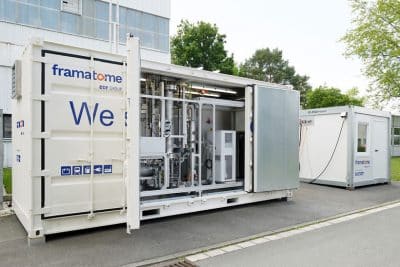Over the past years, Erlangen, in the German state of Bavaria, has become known as the world’s epicenter of LOHC research. It was here that Wolfgang Arlt, a professor at the Friedrich-Alexander University of Erlangen-Nürnberg, conducted his initial experiments on carbazole and other LOHCs, short for liquid organic hydrogen carriers, in 2011. The city is also home to companies such as Hydrogenious and Framatome, which are intent on bringing LOHC technologies to market. Unsurprisingly, a new research facility is being constructed in Erlangen, to help establish a carbon-neutral and sustainable energy supply chain at reasonable cost – a task in which LOHC is to play a key role.
Construction on the main office of the Helmholtz Institute Erlangen-Nürnberg, also known as HI ERN, began in July 2017, on the premises of the Friedrich-Alexander University of Erlangen-Nürnberg, or FAU for short. The 3,200-square-meter, or around 34,400-square-foot, building is scheduled for completion in December 2019, at which point it is said to be used, in partnership with FAU and Helmholtz-Zentrum Berlin, as a satellite site of German research institute Jülich Forschungszentrum. By pooling their expertise, the three organizations aim to conduct research into hydrogen-related materials and processes at the site. More specifically, about 110 staff members will investigate opportunities to create more efficient electrocatalysts and LOHCs.
At the groundbreaking ceremony, Ilse Aigner, who was the state’s economy minister at that time and is now its minister for housing, building and transportation, said that Bavaria had allocated EUR 32 million to finance the project. She added that while the region got a brand-new Helmholtz research facility, the investment would also help widen Bavaria’s lead in scientific fields such as hydrogen storage.
Professor Peter Wasserscheid, HI ERN’s co-founder and president, said, “Working alongside experts in various disciplines, in the midst of a first-class innovation hub such as Erlangen-Nürnberg, provides the fertile ground needed to design new and sustainable technologies.” Professor Otmar Wiestler, the president of the Helmholtz Association, added, “How to produce, store and deliver renewable sources of energy has turned into one of the biggest challenges that society is faced with today.”
LOHCs on track
In April, HI ERN scientists suggested using LOHCs in hydrogen trains. When the states’ transportation ministers met in Nuremberg for their annual gathering, representatives for Jülich Forschungszentrum informed them about a EUR 3 million project launched in early 2018. Supported by Bavaria’s economy ministry, it is said to be exploring the idea of rail-based LOHC applications over three years.
“Refueling points would need a complete overhaul to provide trains with high-pressure or ultra-cold hydrogen. LOHCs, on the other hand, make it possible to repurpose most of the existing equipment,” Wasserscheid said. He added that, in contrast to standard hydrogen, the storage and supply of LOHCs was not limited in scale. Wasserscheid favors dibenzyltoluene, for which low toxicity has been observed.
…
Heat transfer oil to store hydrogen
In Erlangen, LOHC research has not been the exclusive domain of scientific institutes. Hydrogenious Technologies, founded in 2013, and Framatome’s German subsidiary have both been committed to bringing LOHC technologies closer to commercialization. They favor dibenzyltoluene, which consists of aromatic, unsaturated molecules traded under the brand name Marlotherm. Primarily used as a heat transfer oil in industrial settings, the substance can store 9 moles of hydrogen, or 2.3 kilowatt-hours of electric power per kilogram. This is just one-fourth of the gravimetric and volumetric energy density of diesel, but a much more space-saving solution than gaseous hydrogen. Take MYRTE, a test facility on the island of Corsica, where Areva installed a demonstrator called Greenergy BoxTM several years ago. Its LOHC tank requires 0.7 cubic meters for 1.5 megawatt-hours, compared to 14 cubic meters at 35 bars that a typical high-pressure vessel would need to offer the same amount of storage capacity.
…
Framatome’s German subsidiary, formerly known as Areva, has spun off a company named Covalion to handle its LOHC business. Framatome is a nuclear energy company and part of the EDF Group, whose latest project involves the construction of an LOHC installation for HySA Infrastructure, a center of excellence in South Africa (see fig. 2). The new, custom-made container system was shipped to Johannesburg in early June and can store hydrogen at an hourly rate of 4 normal cubic meters in two 500-liter LOHC tanks.
…
N-ethylcarbazole
LOHCs have been an important field of research in other German cities, too. For example, Rhett Kempe, a professor of inorganic chemistry at the University of Bayreuth, and his team put the focus on N-ethylcarbazole, investigating catalysts for their hydrogenation abilities. The current material of choice in Bayreuth is a metal compound of palladium and ruthenium, applied to a silicon carbonitride, or SiCN, carrier. Daniel Forberg, a member of Kempe’s team (see p. 3, fig. 3), said in late 2016, “To date, there is no known catalyst that is more efficient when it comes to adding and removing hydrogen to and from N-ethylcarbazole molecules.”
Moreover, thanks to this catalyst, the scientists have succeeded in creating an LOHC from lignin, a rarely used waste product of wood processing. Kempe said, “We’re really pleased that our catalyst has enabled us to find an efficient and eco-friendly storage material that is available in abundance and has no value as food.” He noted, however, that all his work was basic research, far removed from creating a product ready for the market.
…
LOHC to fuel yachts
Likewise, attempts have been made to establish LOHC fuels in the maritime sector. In February, H2-Industries announced a partnership with Nobiskrug, a Rendsburg-based builder of superyachts, to develop and construct an all-electric LOHC-powered motor vessel.
…



























0 Comments
Trackbacks/Pingbacks